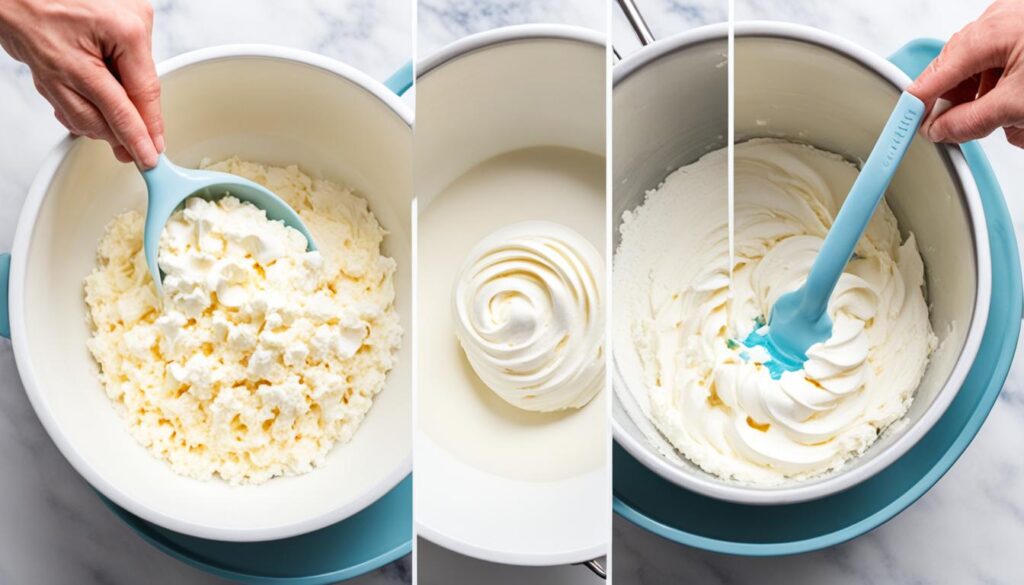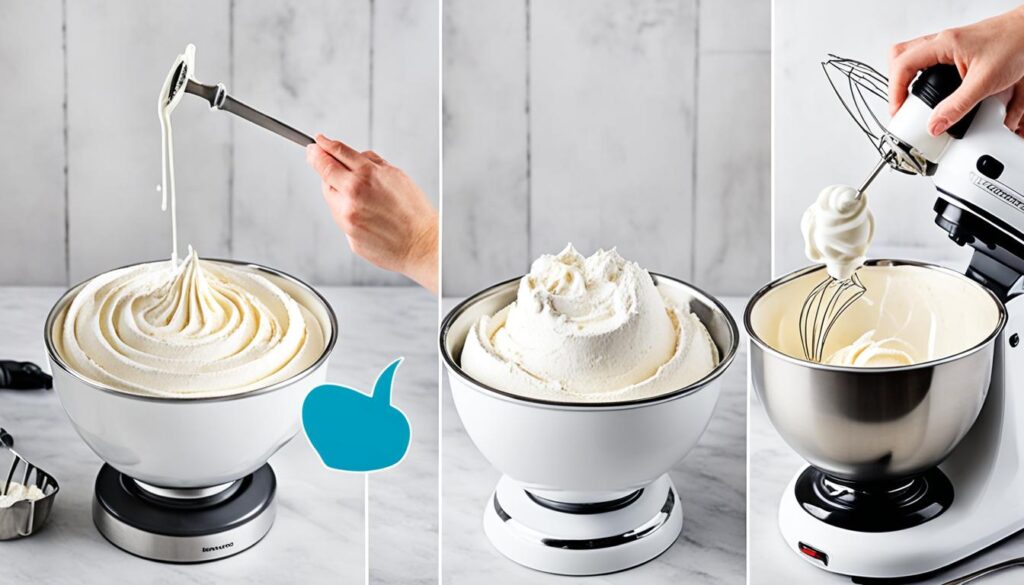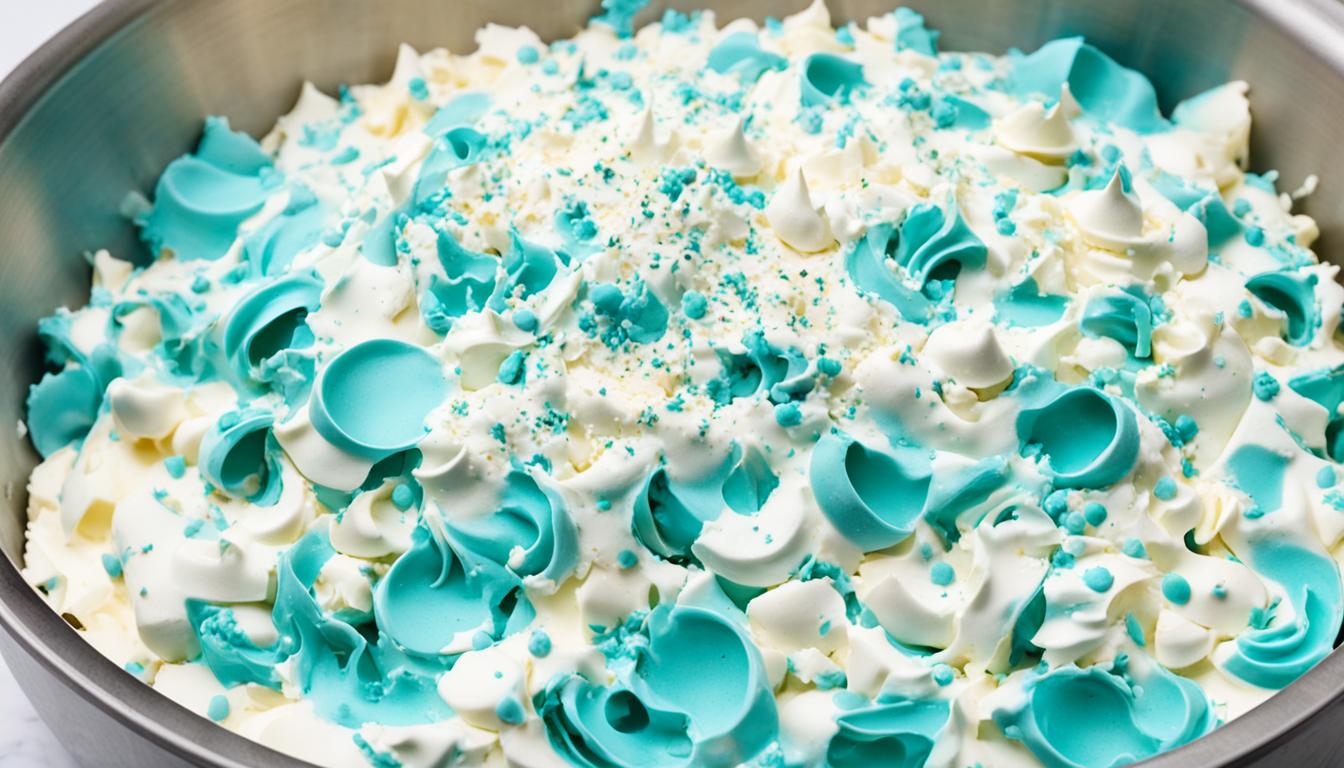Have you ever experienced the frustration of making a beautiful batch of Swiss meringue buttercream, only to have it turn out broken, curdled, or soupy? If you’re tired of wasting time and ingredients, we have the answers you’ve been looking for. In this article, we’ll reveal the secrets to fixing broken Swiss meringue buttercream quickly and effortlessly.
Swiss meringue buttercream is a popular choice for cake frosting due to its light and fluffy texture. However, it can easily become broken, curdled, or soupy, leaving you feeling discouraged. But fear not! By understanding the causes of these issues and following our expert advice, you’ll be able to salvage your buttercream and achieve that perfect, smooth consistency.
Key Takeaways:
- Adjusting the temperature of the buttercream can fix broken Swiss meringue buttercream.
- When the buttercream is curdled, gentle heating methods can help soften the butter and blend it back together.
- If the buttercream is soupy, chilling methods can help thicken it and bring it back to the desired consistency.
- Preventing buttercream issues by ensuring the butter is at the right temperature and avoiding over-mixing can save you from having to fix broken buttercream.
- Understanding the science behind Swiss meringue buttercream can help troubleshoot and prevent common problems.
Understanding Swiss Meringue Buttercream
Swiss meringue buttercream is a delightful frosting known for its stability and light, fluffy texture. Made by combining sugar and egg whites, which are heated until they become fluffy, Swiss meringue buttercream is then enriched by adding soft butter to the meringue. The magic behind its stability lies in the emulsifier present in the butter, allowing it to seamlessly blend with the water-based meringue.
The emulsifier acts as a bridge between the fat and water molecules, preventing them from separating and resulting in a smooth, cohesive buttercream. This is why Swiss meringue buttercream is less prone to breaking compared to other buttercreams.
“Swiss meringue buttercream is a game-changer in the world of frosting. Its stability and velvety texture make it a popular choice among bakers and cake decorators.”
To dive deeper into the science, the emulsion in Swiss meringue buttercream is created by the combination of proteins from the egg whites and the fat molecules from the butter. The proteins in the egg whites bond with the water molecules, while the fat molecules in the butter combine with the fat-loving proteins, creating an emulsion.
As a result, the butter and meringue become homogenized, forming a smooth and airy buttercream that is perfect for frosting cakes and cupcakes. Understanding this science is crucial in troubleshooting and fixing broken Swiss meringue buttercream.
Swiss Meringue Buttercream: A Fluffy Emulsion
In summary, Swiss meringue buttercream is a stable, emulsified frosting created by combining a sugar and egg white mixture with soft butter. The emulsifier in the butter ensures the buttercream remains smooth and cohesive, thanks to its ability to connect the fat and water molecules. This understanding of the science behind Swiss meringue buttercream will greatly assist us in addressing any issues that may arise in creating this delectable frosting.
The Science Behind Swiss Meringue Buttercream
The formation of Swiss meringue buttercream involves the emulsification of fat and water through the combination of the butter and meringue components. It is this emulsion that gives Swiss meringue buttercream its light and silky texture, making it an ideal choice for cake decorators and baking enthusiasts.
By comprehending the chemistry at play, we gain valuable insight into how to prevent and troubleshoot issues that may occur during the buttercream-making process. Armed with this knowledge, we can confidently tackle any challenges that come our way, ensuring the smooth and delicious success of our Swiss meringue buttercream creations.
Fixing Curdled Swiss Meringue Buttercream
Curdled Swiss meringue buttercream is a common issue that can occur when the butter is too cold. This causes the butter to form curds in the mixture, resulting in a less than desirable texture. But don’t worry, there are gentle heating methods you can use to fix curdled buttercream and bring it back to its smooth and creamy state.
Here are a few techniques you can try:
- Room Temperature: Let the curdled buttercream sit at room temperature for some time. The slight warmth will help soften the butter, making it easier to incorporate. Be patient, as this method may take some time.
- Low Heat: Use a hairdryer on low heat to gently warm the curdled buttercream. Keep the hairdryer at a distance to avoid melting the buttercream. Use this method with caution, as excessive heat can cause the buttercream to melt and lose its structure.
- Steam Bath: Create a steam bath by placing the bowl of curdled buttercream over a pot of simmering water. The steam will gently warm the buttercream, helping to soften the butter. Stir occasionally as the buttercream warms up.
- Microwave: If you only have a small amount of curdled buttercream, you can try microwaving it in short intervals. Heat it in 5-second bursts, making sure to stir well between each burst. Again, be cautious to avoid melting the buttercream.
Once the curdled buttercream has been gently heated and the butter has slightly softened, it’s time to remix it. Use an electric mixer on low speed to blend the buttercream until it comes together and has a smooth consistency. If needed, you can add a bit of extra softened butter to restore the desired texture.
Remember to be patient and take your time when fixing curdled buttercream. It may require a few attempts or a combination of methods to achieve the perfect texture. With a little care and gentle heating, your buttercream will be smooth, velvety, and ready to adorn your delicious cakes.
Fixing Soupy Swiss Meringue Buttercream
Soupy Swiss meringue buttercream is a common issue that can occur when the butter gets too warm and melts in the mixture. If you find yourself with a soupy buttercream, don’t worry, it can be fixed!
- Chilling Method:
One of the most effective ways to fix soupy buttercream is by chilling it until it thickens. Simply place the bowl of buttercream in the refrigerator for a specific amount of time. The length of time will depend on the quantity of buttercream you are working with. Be sure to check the consistency periodically until it has thickened to your desired texture.

- Mixing Technique:
After the buttercream has been chilled and thickened, it’s important to mix it back to its desired consistency. Start by using a low speed on your mixer. This will help prevent any air bubbles from forming and ensure a smooth, velvety texture. Mix until the buttercream has reached the desired consistency.
“Chilling soupy buttercream can help it regain its structure and thickness.”
By following these chilling and mixing methods, you can fix a soupy Swiss meringue buttercream and achieve a smooth and creamy texture perfect for frosting cakes.
Common Mistakes to Avoid
When fixing soupy buttercream, it’s important to avoid some common mistakes that can hinder the process. Ensure that the bowl and utensils you use are completely dry before starting. Any moisture can interfere with the emulsion process and prevent the buttercream from thickening properly. Additionally, make sure to use soft, room temperature butter to prevent it from melting too quickly and causing the buttercream to become soupy again.
Preventing and Troubleshooting Swiss Meringue Buttercream Issues
While understanding how to fix broken Swiss meringue buttercream is important, it’s also helpful to prevent these issues from occurring in the first place. By following these tips, you can ensure that your buttercream turns out smooth and perfect every time.
Tips for Preventing Buttercream Issues
- Ensure proper butter temperature: Make sure the butter is softened to room temperature before adding it to the meringue. Softened butter will blend smoothly into the mixture and prevent curdling or a soupy consistency.
- Separate eggs properly: When separating the egg whites, be careful not to get any yolks in the mixture. Even a small amount of yolk can affect the stability of the buttercream.
- Avoid over-mixing: Be mindful not to over-mix the buttercream once the butter has been added. Over-mixing can cause the buttercream to become too dense or develop air bubbles.
Common Problems with Swiss Meringue Buttercream
Being aware of common issues with Swiss meringue buttercream can help you troubleshoot and prevent them from happening.
Buttercream becoming too warm: If the buttercream becomes too warm, it can result in a soupy consistency. This can happen when the room temperature is too high or when the butter is softened too much. To fix this, you can chill the buttercream in the refrigerator for 10-15 minutes before rewhipping.

Buttercream becoming too cold: On the other hand, if the buttercream becomes too cold, it can appear curdled. This can happen when the butter is too cold or when the meringue is not fully incorporated before adding the butter. To fix this, you can gently heat the buttercream by leaving it at room temperature for a few minutes or by using a hairdryer on low heat while mixing.
Preventing Buttercream Issues
| Issue | Prevention Tips |
|---|---|
| Curled Buttercream | Avoid using cold butter and ensure that the meringue is fully incorporated before adding the butter. If the buttercream starts to curdle, gently heat it until slightly softened and then remix until smooth. |
| Soupy Buttercream | Make sure the butter is not too warm and avoid over-softening. If the buttercream becomes soupy, chill it in the refrigerator for a few minutes and then mix on low speed until it thickens. |
Conclusion
Fixing broken Swiss meringue buttercream is a simple process that starts with adjusting the temperature of the buttercream. Whether your buttercream is curdled or soupy, there are specific techniques to fix each issue and restore its smooth texture for cake frosting.
To fix curdled buttercream, gently heat it until slightly softened. This can be done by leaving it at room temperature, using a hairdryer on low heat, placing it on a steam bath, or microwaving a small portion of the mixture. Once the buttercream is slightly softened, remix it until it comes together smoothly.
If your buttercream is soupy, chill it until it thickens. Place the bowl of buttercream in the refrigerator for a specific amount of time, depending on the quantity. After chilling, mix the buttercream on low speed until it thickens to the desired consistency.
Understanding the science behind Swiss meringue buttercream is crucial to troubleshooting and preventing future issues. The stability of this frosting comes from the emulsifier in the butter, which connects the fat and water, preventing separation. By ensuring that the butter is at the right temperature, separating the egg whites properly, and avoiding over-mixing, you can prevent common problems with Swiss meringue buttercream.
In conclusion, by following the recommended techniques, troubleshooting when necessary, and taking preventive measures, you can fix and avoid broken Swiss meringue buttercream. Enjoy the process of creating smooth and delicious buttercream for your cakes every time.
